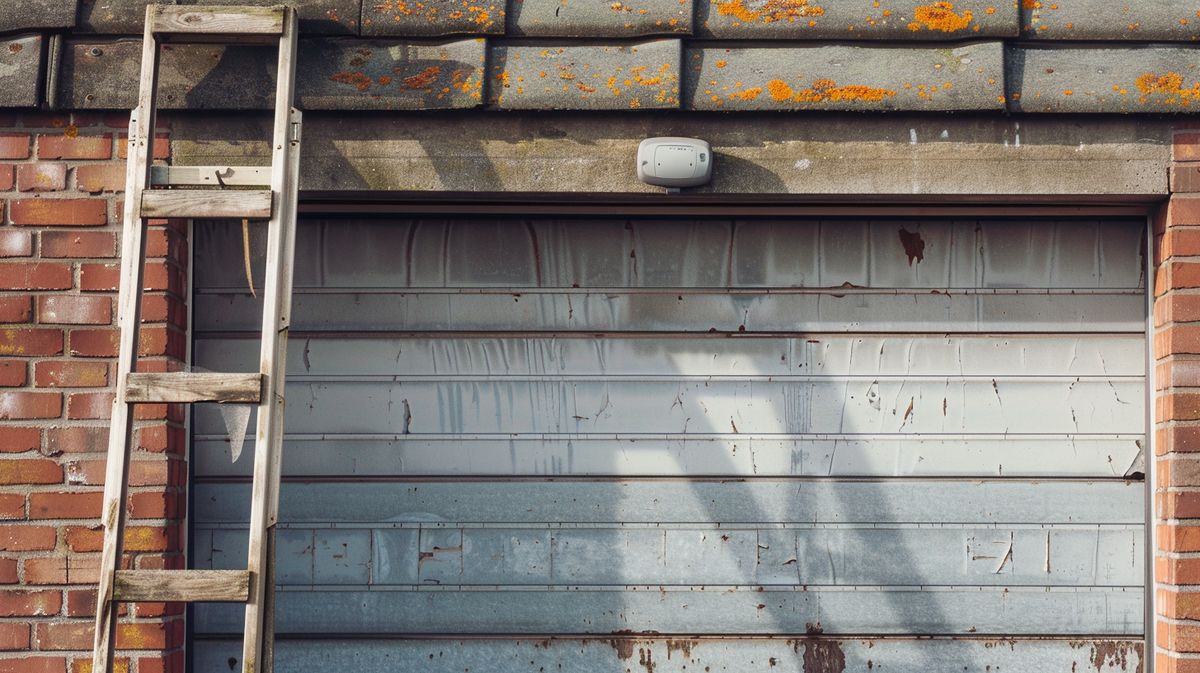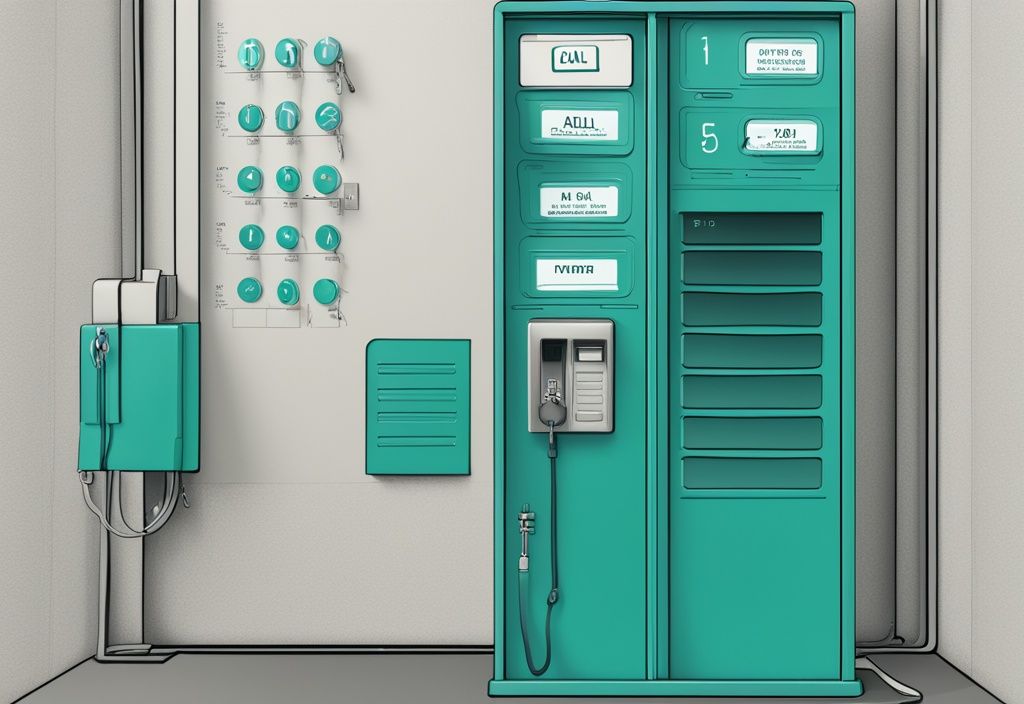Expert Guide on Garage Door Alarm Sensor Installation for Secure Homes
Did you know an unsecured garage is a common were for burglars to gain entry? That’s where a garage door alarm sensor comes to the rescue, enhancing your home security setup. As an experienced home security advisor, I’ll guide you through the process of the garage door alarm sensor installation, turning your garage from a weak link to a fortress.
We will touch upon the different types of sensors available, each with their strengths and installation process. From your traditional open-door sensor to cutting-edge motion sensors, there’s a choice for every home.
On top of this, I’ll also share insider tips on maintaining these security devices for their optimum performance, ensuring round-the-clock safety for your loved ones and valuables. Ready to level up your home security?
Introduction to Garage Door Alarm Sensor Installation
Garage door alarm sensors play a crucial role in enhancing home security. Imagine them as silent guardians, always watching over your home’s entry points. These devices monitor the status of your garage door and trigger alarms if any unusual activity is detected. By adding an extra layer of protection, they help prevent unauthorized access and ensure the safety of your home and belongings.
Think about it—what if you knew the moment someone tried to mess with your garage door? That’s the peace of mind garage door alarm sensors offer. There are three primary types of these sensors, each with its own special job:
- Safety Reverse Sensors: Using infrared light, these sensors detect obstacles under the garage door. If something’s in the way, they signal the opener to reverse direction, preventing accidents. It’s like having an extra set of eyes.
- Contact Sensors: Positioned on the door and its frame, these sensors alert you when the door is physically opened. They are great for immediate intrusion detection—essentially, you’ll know when someone tries to access your garage.
- Tilt Sensors: Mounted inside the garage door, tilt sensors detect changes in the door’s angle. Unusual tilting means forced entry, which prompts the alarm to sound. It’s your early warning system.
This guide dives into the nitty-gritty of Garage Door Alarm Sensor Installation. First, we’ll highlight the importance of garage door safety, followed by detailed explanations and installation instructions for various sensor types. Not sure what you’ll need? We’ve got you covered with a list of necessary tools and materials. We’ll walk you through a step-by-step installation process and even share maintenance tips.
By following these guidelines, you’ll significantly enhance the security and functionality of your garage door system.
Importance of Garage Door Safety
Garage door safety encompasses crucial aspects that protect your family and belongings. This section dives into three key areas: Ensuring family and belonging protection, legal requirements for safety sensors, and advantages of alarm sensors.
Ensuring Family and Belonging Protection
Safety reverse sensors are a lifesaver. They stop your garage door when something—a person, animal, or object—is in its path. Think of it as having an extra pair of eyes to keep an eye out, especially if you have kids or pets. These sensors are essential for a safe home environment.
But that’s not all. Garage door alarm sensors are equally important. They detect unauthorized attempts to open your garage door and trigger an alert. This feature is a powerful deterrent to potential intruders and provides instant notifications, keeping you one step ahead. Imagine the peace of mind knowing your garage is monitored and safe against theft and unauthorized access. Plus, they protect your valuable items, like vehicles, tools, and sports gear. If you’re having trouble with your garage door sensors, learn more about how to fix garage door sensor issues.
Legal Requirements for Safety Sensors
Did you know that in the U.S., it’s federal law to have safety reverse sensors on all automatic garage doors? These laws are there to prevent accidents, keeping your family safe. It’s like having a safety net that ensures your garage door operates without causing harm. For more information on the entrapment protection requirements mandated by the Consumer Product Safety Improvement Act of 1990, you can visit the official announcement by the Consumer Product Safety Commission at https://www.cpsc.gov/Newsroom/News-Releases/1993/Safety-Commission-Publishes-Final-Rules-For-Automatic-Garage-Door-Openers. These laws are there to prevent accidents, keeping your family safe. It’s like having a safety net that ensures your garage door operates without causing harm.
Local regulations can add another layer. Some areas mandate specific requirements for garage door alarm sensors. It’s vital to check these local laws to stay compliant. Ignoring these can lead to hefty fines and increased liability in case of accidents. Proper installation and regular maintenance are not just about safety—they’re also about staying on the right side of the law.
Advantages of Alarm Sensors
Installing garage door alarm sensors brings a host of benefits. First up, they give you peace of mind. Knowing your garage is safeguarded against intruders lifts a huge weight off your shoulders.
Modern alarm sensors integrate seamlessly with smart home systems. You can monitor and control them remotely via your smartphone. Whether you’re at work or on vacation, you can keep an eye on things, ensuring your property is secure.
Here’s another bonus: insurance savings. Many insurance companies offer discounts for homes with advanced security systems, potentially reducing your premiums. Lastly, garage door alarm sensor installation isn’t just effective—it’s also easy and budget-friendly. It’s a smart move to enhance your home’s security without breaking the bank.
Understanding Garage Door Sensor Types
Choosing the right garage door sensors can make a world of difference in keeping your home safe. Let’s dive into the different types and how they contribute to overall security.
Safety Reverse Sensors
How Safety Reverse Sensors Work
Imagine a set of invisible eyes watching over your garage. These safety reverse sensors use sophisticated photo-eye technology and infrared light to spot anything in the door’s path. You’ve got two units, each positioned on either side of the garage door. They send signals to each other, and the moment something breaks that beam—be it a toy, a pet, or a person—the garage door instantly reverses course. The result? Fewer accidents and a safer home environment.
Installation Guidelines for Safety Reverse Sensors
- Positioning: Mount these sensors about 6 inches above the floor on each side of the garage door track. This height is perfect for catching any obstructions.
- Alignment: Ensure both sensors are level and directly facing each other. Use a level tool—precision here is crucial, as even slight misalignments can cause hiccups in operation.
-
Securing and Wiring: Secure the sensors tightly to the mounting brackets with screws. After positioning, connect the sensor wires to the garage door opener as per the manufacturer’s instructions.
In this video, Louie Fordini from Ace Hardware walks you through the step-by-step process of installing garage door safety sensors, ensuring your garage door operates safely and effectively. Learn how to position, wire, and test the sensors for optimal performance.
Proper wiring is key to a smooth, interruption-free system.
Alarm Sensors
Alarm sensors are your frontline defense against unauthorized access. They come in two main varieties: contact sensors and tilt sensors. Each type offers unique mechanisms to detect and alert you to potential threats. Here’s how they work and why they’re indispensable for your home security.
Contact Sensors
Contact sensors are the guardians directly attached to your garage door. They’re mounted on the edge of the door and the frame. When the door opens, the sensor mechanism disconnects, setting off an alarm. Think of them as your digital watchdogs, constantly alerting you to any unexpected openings. Perfect for keeping an eye on unauthorized access and ramping up your overall security.
Tilt Sensors
Tilt sensors offer a different flavor of security. Placed near the top of the garage door’s inside, they monitor changes in the door’s angle. If the door tilts or lifts in an unexpected way, these sensors trigger an alarm. They’re ideal for detecting tampering efforts even when the door isn’t fully opened. This added layer of security ensures you’re alerted to forced entries, long before they become a problem.
Tools and Materials Needed for Installation
To successfully carry out the garage door alarm sensor installation, assembling the right tools and materials is essential. Ensuring you have everything on hand will streamline the process and prevent unnecessary interruptions.
- Screwdriver: A versatile tool necessary for attaching sensors and brackets. Depending on your sensor type, a Phillips or flathead screwdriver might be required.
- Drill: Essential for creating precise holes in the garage walls or door frame for mounting brackets and sensors. Ensure you have the correct drill bit size for the screws provided in your sensor kit.
- Measuring Tape: Critical for accurate placement of sensors, ensuring they are positioned correctly as per manufacturer instructions. This helps in maintaining the alignment required for effective operations.
- Ladder: Often a necessity for reaching higher positions on the garage door during sensor installation. Ensure it is sturdy and of appropriate height to ensure safety.
- Mounting Tape: Useful for temporarily positioning sensors and brackets during the installation process. For those interested in understanding more about motion detection technology, you can explore What Is Motion Warning on Ring and its applications. It ensures proper alignment before permanent attachment using screws.
- New Wiring (Optional): For installations requiring additional connections, such as running Ethernet for PoE cameras or extra sensors. This could enhance the functionality and integration of your security system.
By gathering these tools and materials, you can ensure a smooth and hassle-free garage door alarm sensor installation. Each item plays a crucial role in different stages of the process, aiding in precision and efficiency.
To ensure a smooth and hassle-free garage door alarm sensor installation, gathering the right tools and materials is key. Imagine trying to bake a cake without measuring cups, it just wouldn’t turn out right! The same goes for installing your alarm sensors. Having everything handy will keep the process flowing smoothly.
- Screwdriver: Think of it as your all-purpose tool, essential for attaching sensors and brackets. Depending on your sensor type, you might need a Phillips or flathead screwdriver.
- Drill: Got to make those precise holes in the garage walls or door frame for mounting brackets and sensors. Make sure you have the correct drill bit size for the screws that come with your sensor kit.
- Measuring Tape: Imagine trying to hang a picture without measuring—doesn’t work, right? The same goes here. Accurate placement of sensors is crucial for them to function properly. Follow the manufacturer’s instructions to get it just right.
- Ladder: Need to reach higher spots on the garage door? A sturdy ladder is your best friend. Make sure it’s of the right height to prevent any safety mishaps.
- Mounting Tape: This tape is like your third hand, handy for temporarily positioning sensors and brackets during installation. It helps you ensure everything is aligned before you lock it in with screws.
- New Wiring (Optional): If your installation needs additional connections—like running Ethernet for PoE cameras—having new wiring ready can be a game-changer. It’ll help in enhancing your security system’s functionality and integration.
By assembling these tools and materials, you’re setting yourself up for a successful garage door alarm sensor installation. Every item has its own role in ensuring precision and efficiency. Can you imagine trying to cook a meal without the right ingredients on the kitchen counter? It’s the same idea—let’s make this process straightforward and hassle-free.
Step-by-Step Guide to Installing a Garage Door Alarm Sensor
Follow these steps to effectively install your garage door alarm sensor for enhanced home security and safety.
Preparation and Precautions
Unplugging the Garage Door Opener
Before you dive into the garage door alarm sensor installation, unplug the garage door opener. This simple yet crucial safety step prevents accidental door operation, minimizing injury risks. It also shields you from potential electrical hazards during sensor and wire handling.
Identifying the Mounting Brackets
Find the mounting brackets included in your sensor kit. Examine them closely to grasp their design and use. Next, spot the correct installation points on your garage door track. For detailed guidance on similar installations, you can check out our article on How to Set Up Ring Doorbell That Is Already Installed. These points are usually highlighted in the sensor manual and are vital for proper sensor alignment and performance.
Mounting the Brackets and Sensors
Discover the strategies for properly mounting both brackets and sensors to ensure functionality and safety.
Placement of Brackets
Install the brackets on each side of the garage door track, roughly 6 inches above the ground. This height is key for the sensors to detect obstructions effectively. Correct placement is essential to maximize sensor functionality, prevent accidents, and ensure smooth garage door operation.
Securing the Brackets and Sensors
Secure the brackets to the designated points on the garage door track using a drill and screws. Afterward, attach the sensors to the brackets. Make sure the sensors are level and directly face each other, enabling precise obstacle detection. This alignment is crucial for a successful garage door alarm sensor installation.
Connecting and Testing the Sensors
Learn how to connect your sensors to the garage door opener and test their functionality to ensure proper operation.
Wiring Connections
Follow the manufacturer’s instructions to connect the sensor wires to the garage door opener. Ensure all connections are tight to avoid malfunction. Proper wiring is essential for effective communication between the sensors and the garage door opener, ensuring the door reverses if an obstruction is detected.
Testing for Proper Functionality
Once the wiring is complete, test the sensors to confirm they’re working correctly. Place an object in the sensor’s path and try to close the garage door. The door should reverse upon detecting the object. If not, adjust the sensor alignment or inspect the wiring to resolve any issues. This final step confirms that your garage door alarm sensor installation is effective and fully operational.
Step-by-Step Guide to Garage Door Alarm Sensor Installation
Preparation and Precautions
Choosing the Correct Alarm Sensor
When you’re picking an alarm sensor for your garage door, make sure it works with your current garage door opener. Do you need contact sensors that detect physical openings and closings, or would tilt sensors, which sense changes in the door’s angle, be better? Also, think about your environment—humidity and temperature matter. If needed, go for weather-resistant outdoor contact sensors.
Mounting the Sensors
Placement on the Garage Door
- Contact Sensors: Install contact sensors on the edge of the door and its frame for the best results. Both sensor parts need to be perfectly aligned to detect when the door opens or closes. If they’re off even a little, you might miss an alert.
- Tilt Sensors: Place tilt sensors near the top inside part of the garage door. This spot helps catch any unusual tilts that could mean someone’s trying to force their way in.
Securing the Sensor for Optimal Performance
It’s vital to mount the sensors securely to avoid false alarms from movements or vibrations. Make sure they’re properly positioned to maintain a clear signal transmission range. Use strong mounting tape or screws as the manufacturer suggests for a firm fit.
Connecting and Testing the Sensors
Wiring and Signal Testing
Follow the manufacturer’s guidelines closely when connecting the alarm sensor to your security system or control panel. Once connected, perform a signal test to confirm the sensor triggers an alert when the garage door opens. If the sensor isn’t transmitting well, adjust its position until you’re confident it’s reliable.
Configuring with Security Systems
Label each sensor clearly in your security system, such as “garage door sensor,” for easy identification. Run a thorough test of the entire system to ensure everything works seamlessly together. Check that the alarm goes off correctly and that you get notifications through your security system interface.
Maintenance and Troubleshooting
Garage Door Alarm Sensor Installation is a key aspect of home security. To ensure your system functions seamlessly, regular maintenance and effective troubleshooting are essential. Let’s dive into some practical tips.
Regular Maintenance Tips
Cleaning Sensor Lenses
If you’ve noticed your garage door alarm sensors aren’t as responsive, it might be time for a lens cleaning. Dust and debris collect quickly, and even a thin layer can affect performance. Think of it like cleaning your glasses—everything becomes clearer! Use a soft, non-abrasive cloth and a mild cleaning solution. Harsh chemicals? Definitely a no-go. They could damage the lenses and reduce accuracy.
Checking Battery Life
Ever had your remote control die right when you need it most? The same can happen with your wireless garage door alarm sensors. Make it a habit to check the batteries every quarter. Low batteries can lead to unreliable performance, or worse, no performance at all. So set that calendar reminder and use high-quality batteries for longer life and peace of mind.
Common Issues and Solutions
Alignment Problems
Misaligned sensors aren’t just an inconvenience—they can be a safety hazard. If your sensors aren’t aligned properly, they can’t do their job. Grab a spirit level and measuring tape. Make sure each sensor faces its counterpart directly and sits level. Sometimes, the issue might be an obstruction or a bent bracket, so give those a check as well.
Signal Transmission Issues
Weak signals can disrupt the harmony of your garage door system. If your sensors are missing the mark, repositioning them might help. Think of it like adjusting the antenna on an old TV for better reception. Signal boosters or repeaters can also work wonders. Just make sure there aren’t any large metal objects or electronic devices nearby that might interfere.
Wiring and Connectivity Troubles
Loose wires are often the culprits behind malfunctioning sensors. Double-check all connections to ensure they are secure and properly installed according to the manufacturer’s guidelines. If persistent problems occur, it may be time to replace old wiring. Always consult the user manual, and don’t hesitate to call a pro if needed.
When to Call a Professional
Complex installations or stubborn issues can be frustrating. When basic troubleshooting fails, it’s wise to bring in a professional for your garage door alarm sensor installation. They have the know-how to get everything working perfectly and usually offer a warranty for their services. This ensures not just proper setup but also that you’ve got everything in place for optimal security.
Conclusion
Recap the Key Points Covered in the Guide
In wrapping up, let’s recap the pivotal points discussed throughout this comprehensive guide on garage door alarm sensor installation. We delved into the fundamentals of garage door alarm sensors, highlighting their purpose and types, including safety reverse sensors, contact sensors, and tilt sensors.
Emphasize the Importance of Proper Installation for Effective and Safe Operation
Proper installation of garage door alarm sensors is paramount to their effective and safe operation. Ensuring that each sensor is correctly mounted, securely wired, and accurately aligned cannot be overstressed. Misalignment, poor wiring, or incorrect placement can lead to malfunctions that might compromise the security and safety of your garage. By following the step-by-step guides provided, you can avoid common pitfalls and ensure that your sensors work flawlessly. Remember, the security of your home and the safety of its occupants hinge greatly on the meticulous installation of these devices.
Encourage Regular Maintenance and Troubleshooting to Ensure Long-term Functionality
Lastly, regular maintenance and proactive troubleshooting play a critical role in the longevity and functionality of garage door alarm sensors. Simple actions such as cleaning sensor lenses, checking battery life, and ensuring signal integrity can prevent potential issues down the line. Addressing alignment and connectivity problems promptly is vital in maintaining the seamless operation of your security system. Should any complex issues arise, do not hesitate to seek professional assistance. With diligent maintenance and timely troubleshooting, you can ensure your garage door alarm sensors provide reliable protection for years to come.
FAQ
What tools are needed for garage door alarm sensor installation?
When it comes to **garage door alarm sensor installation**, you’ll need a few essential tools: a screwdriver, drill, measuring tape, ladder, and mounting tape. Think of it like assembling a complicated Lego set, but instead of blocks, you’re working with vital security components. Sometimes, new wiring is also necessary, particularly if you’re integrating extra sensors or PoE cameras.
Imagine trying to fill a puzzle’s gaps with just the right pieces – that’s how crucial each tool will be to your installation process.
How do safety reverse sensors work?
Safety sensors are essentially the vigilant eyes of your **garage door alarm system**. They employ photo-eye technology using infrared light. Picture them like invisible laser beams casting an alert gaze. The moment they detect an obstruction, they spring into action, reversing the garage door to ward off accidents. It’s like having a steadfast guard, always ready to avert a potential mishap.
Are safety sensors legally required?
In the United States, U.S. federal law has your back on this one. Safety reverse sensors aren’t just optional – they’re a legal must for automatic garage doors. So, it’s akin to having mandatory seatbelts in cars. Always double-check local regulations, though, as there may be specific stipulations about **alarm sensors** in your area.
Do I need a professional to install garage door sensors?
Sure, DIY projects can be rewarding – like crafting a model ship from scratch. But, when it comes to garage door sensors, unless you’re adept at intricate security systems, opting for professional installation is wise. Professionals ensure your system is seamlessly integrated, saving you from potential headaches or security lapses down the line.
What are common issues with garage door sensors?
Just like any intricate system, **garage door sensors** can encounter a few hiccups. Common issues include poor installation, wiring problems, and alignment woes. Sometimes, sensors get dirty or obstructed, blocking them from doing their job. Weak signal transmission can also be a pesky problem. Think of it like trying to tune into an old radio station – even the smallest interference can disrupt its function.
By addressing these issues with the precision and care they demand, you help maintain a robust layer of security around your home, much like a steadfast knight guarding a castle. So, ensuring your garage door sensors are in top shape is an investment in daily peace of mind!
I’m James Albright, a home security expert with over 15 years of experience, and I’m passionate about helping families protect what matters most. After serving as a police officer, I transitioned to security consulting to share my hands-on knowledge and practical tips. My mission is to make home security simple and reliable by offering clear, no-nonsense advice and easy-to-follow guides. When I’m not reviewing the latest security tech or writing, I’m out in the community leading neighborhood watch programs and, most importantly, keeping my own family safe.





Post Comment